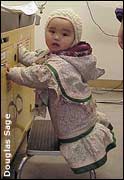|
|
Highlights of this issue

Lower respiratory tract infections in Inuit children
 Compared with non-Aboriginal children, Aboriginal children are known to suffer more frequent and more severe lower respiratory tract infections, which often require hospital care and mechanical ventilation. Anna Banerji and colleagues studied cases of lower respiratory tract infection in Inuit infants admitted to the Baffin Regional Hospital. They found an annualized incidence rate of 484 per 1000 infants under 6 months old. Of the 27 admissions (26 infants) they studied, 3 (12%) required intubation. Probable pathogens were identified in 18 of the 27 cases. All infants were exposed to maternal cigarette smoking in utero, second-hand smoke at home and crowded living conditions.
Compared with non-Aboriginal children, Aboriginal children are known to suffer more frequent and more severe lower respiratory tract infections, which often require hospital care and mechanical ventilation. Anna Banerji and colleagues studied cases of lower respiratory tract infection in Inuit infants admitted to the Baffin Regional Hospital. They found an annualized incidence rate of 484 per 1000 infants under 6 months old. Of the 27 admissions (26 infants) they studied, 3 (12%) required intubation. Probable pathogens were identified in 18 of the 27 cases. All infants were exposed to maternal cigarette smoking in utero, second-hand smoke at home and crowded living conditions.
Creating a Canadian stroke system
Stroke accounts for 7% of all deaths in Canada, and 4% of people aged 65 years and over are living with the effects of a stroke. Until recently, treatment was limited. Results from randomized controlled trials now indicate that treatment within 3 hours after stroke onset can reduce and may prevent neurological damage. We must now use this knowledge, say Elinor Wilson and coauthors, to establish a comprehensive, effective and efficient approach to stroke that incorporates prevention, pre-hospital and emergency care, hospital care, rehabilitation, reintegration into the community and research.
Should we teach breast self-examination?
 Many studies have examined the effectiveness of various screening tools for breast cancer, the most frequently diagnosed cancer among Canadian women. In 1994 the Canadian Task Force on the Periodic Health Examination (now the Canadian Task Force on Preventive Health Care) concluded that there was insufficient evidence to recommend for or against screening using breast self-examination (BSE). In revisiting the topic, the task force has reviewed relevant articles published since then, and it now concludes that there is fair evidence to recommend that BSE not be routinely taught to women aged 40–69 years. In a related commentary, Larissa Nekhlyudov and Suzanne Fletcher question whether this change is premature and wonder how women will react to a reversal in medical advice about a method that has become so widely accepted.
Many studies have examined the effectiveness of various screening tools for breast cancer, the most frequently diagnosed cancer among Canadian women. In 1994 the Canadian Task Force on the Periodic Health Examination (now the Canadian Task Force on Preventive Health Care) concluded that there was insufficient evidence to recommend for or against screening using breast self-examination (BSE). In revisiting the topic, the task force has reviewed relevant articles published since then, and it now concludes that there is fair evidence to recommend that BSE not be routinely taught to women aged 40–69 years. In a related commentary, Larissa Nekhlyudov and Suzanne Fletcher question whether this change is premature and wonder how women will react to a reversal in medical advice about a method that has become so widely accepted.
Technetium 99m in the laboratory
 The sentinel lymph node is the first lymph node draining a tumour and thus the first site of lymphatic nodal metastasis. It may be identified through injection of a technetium-99m–labelled tracer at the tumour or scar site. Terence Colgan and coauthors describe procedures for the safe handling of these radioactive biopsy and resection specimens. They recommend that specimens containing the primary injection site be quarantined for at least 24 hours to allow radioactive decay of the isotope. Although this delays reporting of pathology results, it does not adversely affect final patient management.
The sentinel lymph node is the first lymph node draining a tumour and thus the first site of lymphatic nodal metastasis. It may be identified through injection of a technetium-99m–labelled tracer at the tumour or scar site. Terence Colgan and coauthors describe procedures for the safe handling of these radioactive biopsy and resection specimens. They recommend that specimens containing the primary injection site be quarantined for at least 24 hours to allow radioactive decay of the isotope. Although this delays reporting of pathology results, it does not adversely affect final patient management.
Task force recommendations: new format
In the News section of this issue we publish the first summary statement of recommendations from the Canadian Task Force on Preventive Health Care, on varicella vaccination. This new format is intended to help busy clinicians get to the "bottom line" quickly. Interested readers can obtain a copy of the full technical report of the systematic review on which the recommendations are based from the task force office. In a commentary, task force chair John Feightner explains the change.
Copyright 2001 Canadian Medical Association or its licensors |

